人教版小学四年级上册英语第四单元
- 格式:ppt
- 大小:6.58 MB
- 文档页数:5
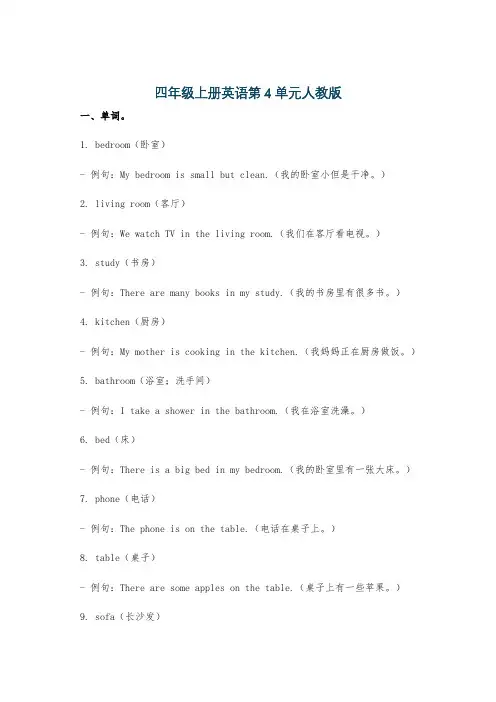
四年级上册英语第4单元人教版一、单词。
1. bedroom(卧室)- 例句:My bedroom is small but clean.(我的卧室小但是干净。
)2. living room(客厅)- 例句:We watch TV in the living room.(我们在客厅看电视。
)3. study(书房)- 例句:There are many books in my study.(我的书房里有很多书。
)4. kitchen(厨房)- 例句:My mother is cooking in the kitchen.(我妈妈正在厨房做饭。
)5. bathroom(浴室;洗手间)- 例句:I take a shower in the bathroom.(我在浴室洗澡。
)6. bed(床)- 例句:There is a big bed in my bedroom.(我的卧室里有一张大床。
)7. phone(电话)- 例句:The phone is on the table.(电话在桌子上。
)8. table(桌子)- 例句:There are some apples on the table.(桌子上有一些苹果。
)9. sofa(长沙发)- 例句:I like to sit on the sofa and read books.(我喜欢坐在沙发上看书。
)10. fridge(冰箱)- 例句:There is some milk in the fridge.(冰箱里有一些牛奶。
)二、句型。
1. Where's...?(……在哪里?)- 这是一个询问地点的特殊疑问句。
例如:- Where's my book?(我的书在哪里?)- Where's the cat?(猫在哪里?)- 回答通常用“It's + 地点.”或者“They're+地点.”(如果是复数物品)。
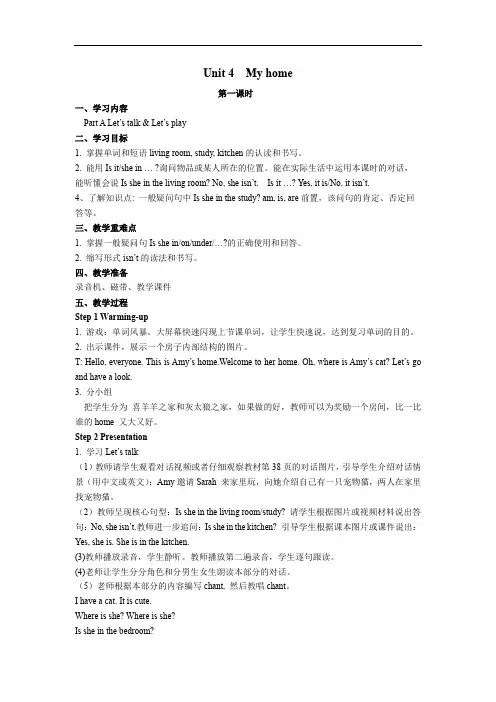
Unit 4 My home第一课时一、学习内容Part A Let’s talk & Let’s play二、学习目标1. 掌握单词和短语living room, study, kitchen的认读和书写。
2. 能用Is it/she in … ?询问物品或某人所在的位置。
能在实际生活中运用本课时的对话,能听懂会说Is she in the living room? No, she isn’t. Is it …? Yes, it is/No, it isn’t.4、了解知识点: 一般疑问句中Is she in the study? am, is, are前置,该问句的肯定、否定回答等。
三、教学重难点1. 掌握一般疑问句Is she in/on/under/…?的正确使用和回答。
2. 缩写形式isn’t的读法和书写。
四、教学准备录音机、磁带、教学课件五、教学过程Step 1 Warming-up1. 游戏:单词风暴。
大屏幕快速闪现上节课单词,让学生快速说,达到复习单词的目的。
2. 出示课件,展示一个房子内部结构的图片。
T: Hello, everyone. This is Amy’s home.Welcome to her home. Oh, where is Amy’s cat? Let’s go and have a look.3. 分小组把学生分为喜羊羊之家和灰太狼之家,如果做的好,教师可以为奖励一个房间,比一比谁的home 又大又好。
Step 2 Presentation1. 学习Let’s talk(1)教师请学生观看对话视频或者仔细观察教材第38页的对话图片,引导学生介绍对话情景(用中文或英文):Amy邀请Sarah 来家里玩,向她介绍自己有一只宠物猫,两人在家里找宠物猫。
(2)教师呈现核心句型:Is she in the living room/study? 请学生根据图片或视频材料说出答句:No, she isn’t.教师进一步追问:Is she in the kitchen? 引导学生根据课本图片或课件说出:Yes, she is. She is in the kitchen.(3)教师播放录音,学生静听。
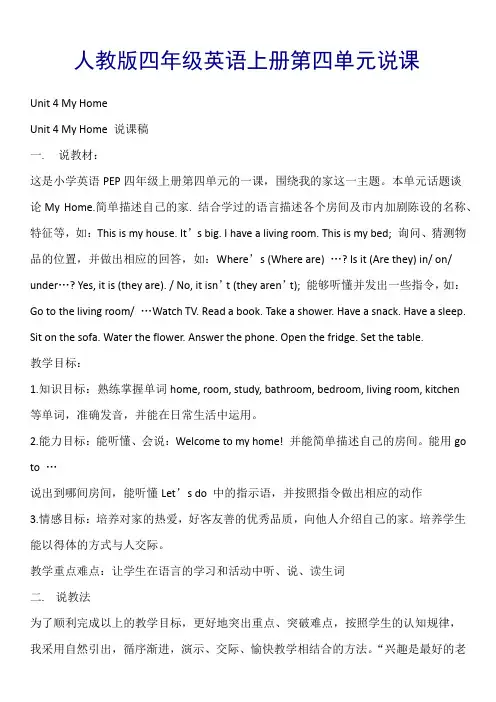
人教版四年级英语上册第四单元说课Unit 4 My HomeUnit 4 My Home 说课稿一.说教材:这是小学英语PEP四年级上册第四单元的一课,围绕我的家这一主题。
本单元话题谈论My Home.简单描述自己的家. 结合学过的语言描述各个房间及市内加剧陈设的名称、特征等,如:This is my house. It’s big. I have a living room. This is my bed; 询问、猜测物品的位置,并做出相应的回答,如:Where’s (Where are) …? Is it (Are they) in/ on/ under…? Yes, it is (they are). / No, it isn’t (they aren’t); 能够听懂并发出一些指令,如:Go to the living room/ …Watch TV. Read a book. Take a shower. Have a snack. Have a sleep. Sit on the sofa. Water the flower. Answer the phone. Open the fridge. Set the table.教学目标:1.知识目标:熟练掌握单词home, room, study, bathroom, bedroom, living room, kitchen等单词,准确发音,并能在日常生活中运用。
2.能力目标:能听懂、会说:Welcome to my home! 并能简单描述自己的房间。
能用go to …说出到哪间房间,能听懂Let’s do 中的指示语,并按照指令做出相应的动作3.情感目标:培养对家的热爱,好客友善的优秀品质,向他人介绍自己的家。
培养学生能以得体的方式与人交际。
教学重点难点:让学生在语言的学习和活动中听、说、读生词二.说教法为了顺利完成以上的教学目标,更好地突出重点、突破难点,按照学生的认知规律,师”。
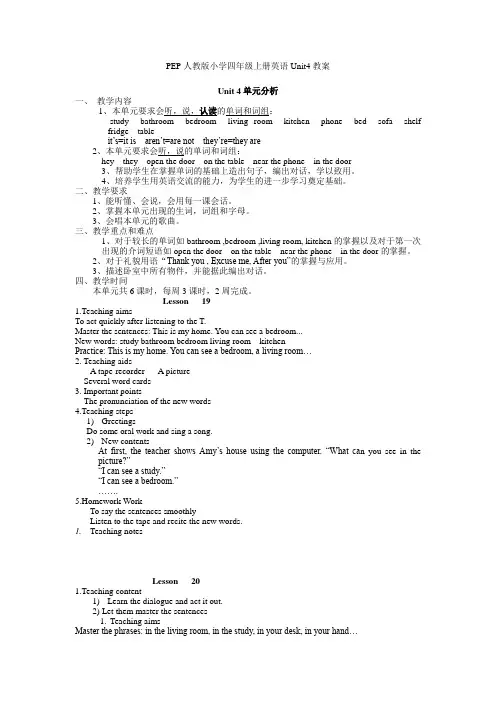
PEP人教版小学四年级上册英语Unit4教案Unit 4单元分析一、教学内容1、本单元要求会听,说,认读的单词和词组:study bathroom bedroom living room kitchen phone bed sofa shelf fridge tableit’s=it is aren’t=are not they’re=they are2、本单元要求会听,说的单词和词组:hey they open the door on the table near the phone in the door3、帮助学生在掌握单词的基础上造出句子,编出对话,学以致用。
4、培养学生用英语交流的能力,为学生的进一步学习奠定基础。
二、教学要求1、能听懂、会说,会用每一课会话。
2、掌握本单元出现的生词,词组和字母。
3、会唱本单元的歌曲。
三、教学重点和难点1、对于较长的单词如bathroom ,bedroom ,living room, kitchen的掌握以及对于第一次出现的介词短语如open the door on the table near the phone in the door的掌握。
2、对于礼貌用语“Thank you , Excuse me, After you”的掌握与应用。
3、描述卧室中所有物件,并能据此编出对话。
四、教学时间本单元共6课时,每周3课时,2周完成。
Lesson 191.Teaching aimsTo act quickly after listening to the T.Master the sentences: This is my home. Y ou can see a bedroom...New words: study bathroom bedroom living room kitchenPractice: This is my home. Y ou can see a bedroom, a living room…2. Teaching aidsA tape-recorder A pictureSeveral word cards3. Important pointsThe pronunciation of the new words4.Teaching steps1)GreetingsDo some oral work and sing a song.2)New contentsAt first, the teacher shows Amy’s house using the computer. “What ca n you see in the picture?”“I can see a study.”“I can see a bedroom.”…….5.Homework WorkTo say the sentences smoothlyListen to the tape and recite the new words.1.Teaching notesLesson 201.Teaching content1)Learn the dialogue and act it out.2) Let them master the sentences1.Teaching aimsMaster the phrases: in the living room, in the study, in your desk, in your hand…Use the dialogue smoothly.3. Important pointsThe pronunciation of the new words4.Teaching aidsA tape-recorder A pictureSeveral word cards5.Teaching steps1.GreetingSing an English song. Ask the students to introduce their homes.2.RevisionLearn the drills and practice the drills.T: What’s this? Ss: An eraser.T: yes, what does it like? S: It looks like a fish.T: Where is my eraser? Is she in the…?Ss: Y es, she is.(No, she isn’t.)Show them several pictures.T: Oh, how beautiful! Where is it?S: This is my bedroom.(This is myLiving-room. This is my bathroom.)T: Is this your ..? S: Y es, it is.(No, is n’t.)Game.-Where is my pen? -Is it in the …?- No, isn’t. - Is it in the …?-Y es, it is.Tell them the difference between “Is it…?” and “Is she…?”Listen to the tape and imitate. Practice in groups and act it out.6.HomeworkTo say the sentences smoothlyRecite the dialogue and listen to tape.2.Teaching notesLesson 211.Teaching AimsLet them master the words :home room school classroom(listening speaking reading and writing)And the sentencesWelcome to my ……home ……This is my ……room ……When they see the pictures, they can recognize and say their English names..2.Teaching Aidsa tape recorder cards pictures3.Important points4-skill words:home room school classroom4.Teaching steps1).Greeting and organizationSing an English song and do oral work.2). RevisionA:Act the dialogue of lesson 21B: Review these words:Home room school classroom3).PresentationRead the words and spell them.Ask a student come to the front to read all the words, and the others after him or her. 4).PracticeListen to the tape, imitate and practice the sentences.Read and spell the words.5. HomeworkSpell the words , then write them:Home room school classroom1.Teaching notesLesson 221.Teaching AimsLet the students master the words and phrase :phone bed shelf fridge table sofaLet the students listen and read these drill:Sit on … Make …Watch TV. Answer… Open… Set…2.Teaching Aidsa tape recorder cards pictures3.Important pointsLearn to say the words: phone shelf fridge table sofaWhen they see the subject, they can recognize and say their English names..4.Teaching steps1).Greeting and organizationSing a song and do a oral work.2). RevisionReview these words:Home room school classroom3).PresentationThe teacher shows the phone of the room and points at something one by one, and the students say it in English. In this way, learn to say the new words:phone shelf fridge table bed sofaAsk a student come to the front to read all the words, and the others read after him.4).Play a game:Passing the eight words between eight groups, and then checking which group did quickly and right.5).PracticeListen to the tape, imitate and practice the words:phone…Read and spell the words.6).Let’s doSit on the sofa. Make the bed. Watch TV. Answer the phone. Open the fridge. Set the table. 5.Homework1. Listen and read the new words and drill.2. Recite “Let’s do”.2.Teaching NotesLesson 231.Teaching content1) DrillsA: Are they on the …? A: Are they near…?B: Y es, they are. (No, they aren’t.)2)Learn the dialogue and act it out .3).Let’s chant.2. Teaching aimsLet them master the short sentences:Open the door on the table near the phoneLearn the new drills.Use the dialogue smoothly.3.important points1).The pronunciation of the new words2). A: Are they on the …? B: Y es, they are.(No, the arearen’t)4.Teaching aidsA tape-recorder A pictureSeveral word cards5.Teaching steps1).Greeting and organizationSing an English song and do oral work. Ask the students to introduce their home.2).At first, the teacher talk to the students.T: Where are the key(book…)?S: It’s on the table(in the desk, near the phone…)T: Where are the keys(books…)?S: They are on the table(in the desk, near the phone…)T: Are they on the table? S: Y es, they are.(No, they aren’t.)Then learn to say the drills. And practise the drill with the Ss. From “the T ask s, theS answers” to “the S asks, the S answers.”3) Then practise these drills smoothly.Play a game.S1:Where are the keys? S2:Are they in he …?S3: No, they aren’t. S2: Are they in the …?S3: Yes, they are.Tell them the different of “Is it…?” or“Are they…?”Listen to the recorder and imitate.Work in groups and act it out.6. HomeworkRecite the dialogue.To say the sentences smoothly3.Teaching notesLesson 241 .Teaching Aims1)Let the students master the four-skill words :Window desk door chair bed2)Let the students read these sentences:What can you see in my room? I can see…When they see the objects, they can recognize and read them and do the action about them.2 .Teaching Aidsa tape recorder.3.Difficult words and emphasis:4-skill letters and words:Window desk door chair bed4.Teaching steps1)OrganizationChant together and do a oral work.2). RevisionSpell the word: Window desk door chair bedPhrase: w_nd_w d_ _r d_sk ch___b_d3).PresentationWhen the teacher point at the subject, the students say the word and spell it. Then write these words.Read the drills smoothly:What can you see in my room?I can see…Read and choose: Listen to the T and choose A,B,C or4).Listen to the tape, imitate and read..5).GameThe teacher asks a student come to the front of the class, and tell him/her a word, then asks other students guess the word.5.HomeworkSpell and write the four-skill words :。
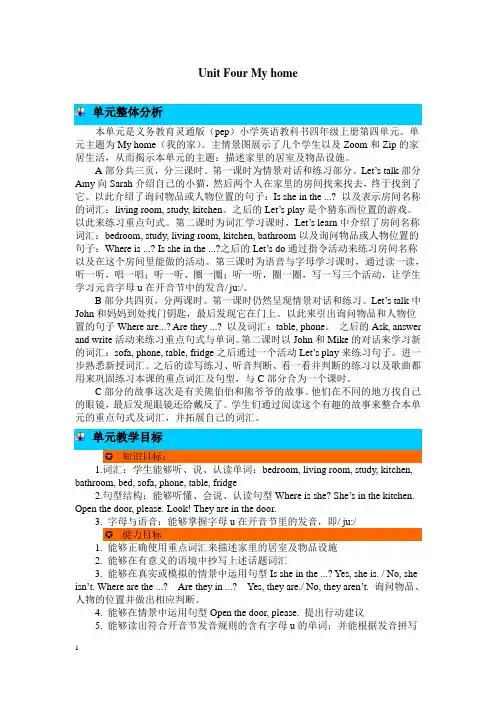
Unit Four My home单元整体分析本单元是义务教育灵通版(pep)小学英语教科书四年级上册第四单元。
单元主题为My home(我的家)。
主情景图展示了几个学生以及Zoom和Zip的家居生活,从而揭示本单元的主题:描述家里的居室及物品设施。
A部分共三页,分三课时。
第一课时为情景对话和练习部分。
Let’s talk部分Amy向Sarah介绍自己的小猫,然后两个人在家里的房间找来找去,终于找到了它。
以此介绍了询问物品或人物位置的句子:Is she in the ...? 以及表示房间名称的词汇:living room, study, kitchen。
之后的Let’s play是个猜东西位置的游戏。
以此来练习重点句式。
第二课时为词汇学习课时,Let’s learn中介绍了房间名称词汇:bedroom, study, living room, kitchen, bathroom以及询问物品或人物位置的句子:Where is ...? Is she in the ...?之后的Let’s do通过指令活动来练习房间名称以及在这个房间里能做的活动。
第三课时为语音与字母学习课时,通过读一读,听一听,唱一唱;听一听、圈一圈;听一听,圈一圈,写一写三个活动,让学生学习元音字母u在开音节中的发音/ju:/。
B部分共四页,分两课时。
第一课时仍然呈现情景对话和练习。
Let’s talk中John和妈妈到处找门钥匙,最后发现它在门上。
以此来引出询问物品和人物位置的句子Where are...? Are they ...? 以及词汇:table, phone。
之后的Ask, answer and write活动来练习重点句式与单词。
第二课时以John和Mike的对话来学习新的词汇:sofa, phone, table, fridge之后通过一个活动Let’s play来练习句子。
进一步熟悉新授词汇。
之后的读写练习、听音判断、看一看并判断的练习以及歌曲都用来巩固练习本课的重点词汇及句型,与C部分合为一个课时。
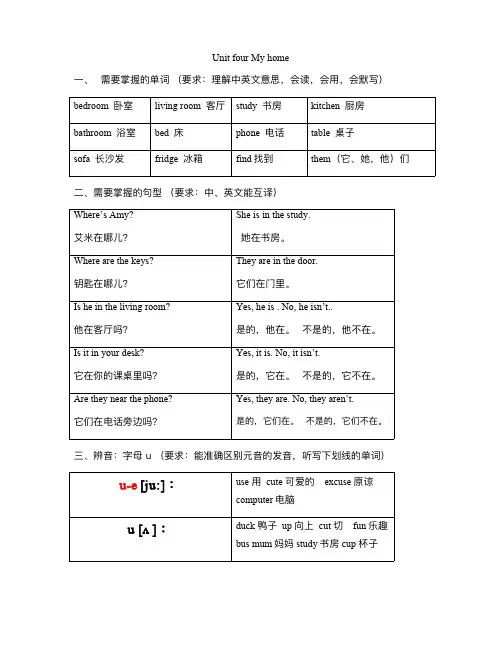
Unit four My home一、需要掌握的单词(要求:理解中英文意思,会读,会用,会默写)bedroom卧室living room客厅study书房kitchen厨房bathroom浴室bed床phone电话table桌子sofa长沙发fridge冰箱find找到them(它、她,他)们二、需要掌握的句型(要求:中、英文能互译)Where’s Amy?艾米在哪儿?She is in the study.她在书房。
Where are the keys?钥匙在哪儿?They are in the door.它们在门里。
Is he in the living room?他在客厅吗?Yes,he is.No,he isn’t..是的,他在。
不是的,他不在。
Is it in your desk?它在你的课桌里吗?Yes,it is.No,it isn’t.是的,它在。
不是的,它不在。
Are they near the phone?它们在电话旁边吗?Yes,they are.No,they aren’t.是的,它们在。
不是的,它们不在。
三、辨音:字母u(要求:能准确区别元音的发音,听写下划线的单词)u-e[ju:]:use用cute可爱的excuse原谅computer电脑u[ʌ]:duck鸭子up向上cut切fun乐趣bus mum妈妈study书房cup杯子四.Let’s doGo to the living room.Watch TV.去客厅看电视。
Go to the study.Read a book.去书房看书。
Go to the kitchen.Have a snack.去厨房吃点心。
Go to the bedroom.Have a nap.去卧室休息。
Go to the bathroom.Take a shower.去浴室冲澡五.语法点1.are开头的问句,回答是yes或者no,然后根据句子的开头进行颠倒变化。

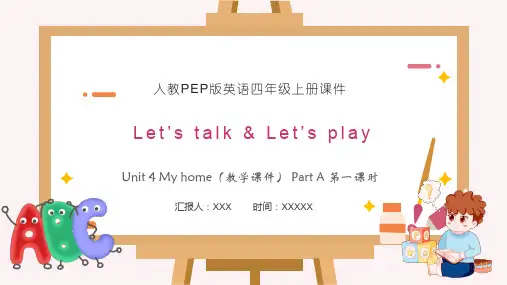
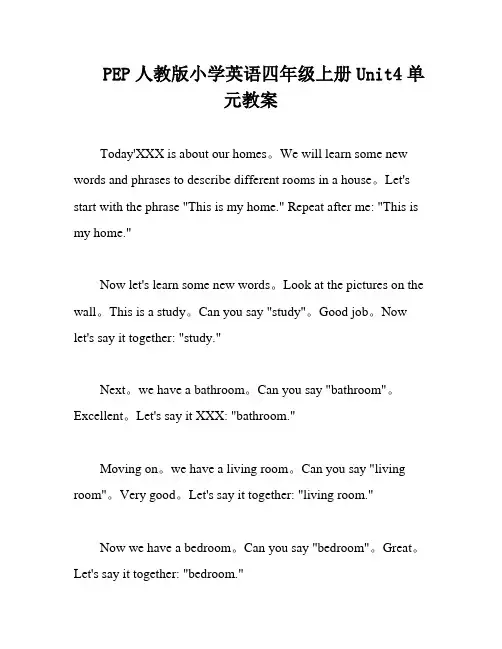
PEP人教版小学英语四年级上册Unit4单元教案Today'XXX is about our homes。
We will learn some new words and phrases to describe different rooms in a house。
Let's start with the phrase "This is my home." Repeat after me: "This is my home."Now let's learn some new words。
Look at the pictures on the wall。
This is a study。
Can you say "study"。
Good job。
Now let's say it together: "study."Next。
we have a bathroom。
Can you say "bathroom"。
Excellent。
Let's say it XXX: "bathroom."Moving on。
we have a living room。
Can you say "living room"。
Very good。
Let's say it together: "living room."Now we have a bedroom。
Can you say "bedroom"。
Great。
Let's say it together: "bedroom."Finally。
we have a kitchen。
Can you say "kitchen"。
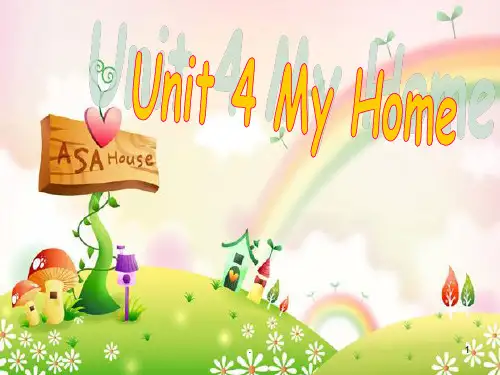
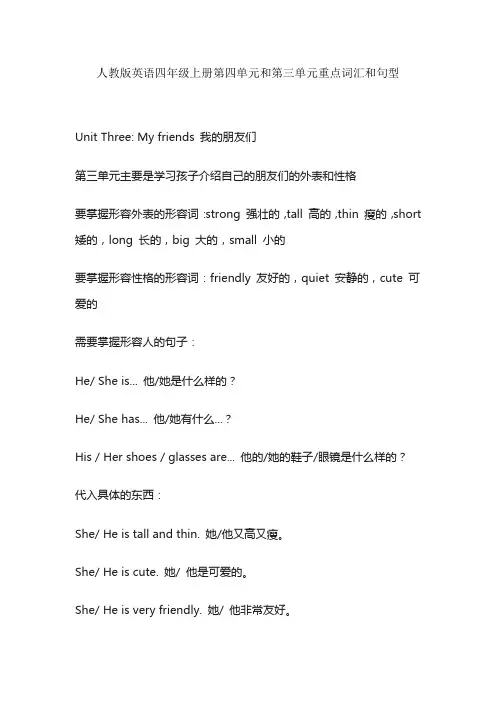
人教版英语四年级上册第四单元和第三单元重点词汇和句型Unit Three: My friends 我的朋友们第三单元主要是学习孩子介绍自己的朋友们的外表和性格要掌握形容外表的形容词:strong 强壮的,tall 高的,thin 瘦的,short 矮的,long 长的,big 大的,small 小的要掌握形容性格的形容词:friendly 友好的,quiet 安静的,cute 可爱的需要掌握形容人的句子:He/ She is... 他/她是什么样的?He/ She has... 他/她有什么...?His / Her shoes / glasses are... 他的/她的鞋子/眼镜是什么样的?代入具体的东西:She/ He is tall and thin. 她/他又高又瘦。
She/ He is cute. 她/ 他是可爱的。
She/ He is very friendly. 她/ 他非常友好。
He/ She has two big eyes and two small ears. 他/ 她有两只大眼睛和两只小耳朵。
His/ Her shoes are blue. 他的/她的鞋子是蓝色的。
记住:形容事物的时候形容词放名词前面,比如a big bag, red glasses, a cute dog...当孩子们想形容自己的朋友时能连贯说出两到三句话,比如:She is tall. She has big eyes and long hair. She is cute. / He is tall and strong. He has red glasses and a yellow schoolbag. He is quiet and friendly.Unit Four: My home 我家这单元主要是学习孩子具体的介绍家或者是自己的卧室,什么东西具体在什么地方。
需要掌握的单词:bedroom 卧室,living room 客厅,study 书房,kitchen 厨房,bathroom 浴室,洗手间,bed 床,phone 电话,table 桌子,sofa 长沙发,fridge 冰箱方位词:in 在...里面,on 在...上面,under 在...下面,near 靠近,在...附近需要掌握的句子:1、Sarah: Where are the keys?钥匙在哪里?Mike: Are they near the table?它们在桌子旁边吗?Sarah: No, they aren’t.没有,它们不在桌子旁边。
人教版四年级英语上册《Unit4 My home》重点难点知识梳理重点:询问人/物品具体位置的句型难点:确认人物品具体的位置能力目标:1.能够在真实或模拟的情景中运用where询问人或物品在哪里2.能够用句型“Is he/she/it+表示地点的介词短语?"和" Are they+表示地点的介词短语?”来询问人或物品的位置3.能够用句型“人/物+be动词+表示地点的介词短语."来描述人或物品在某地【重点单词与词汇】bedroom 卧室study 书房kitchen 厨房bathroom 浴室;洗手间bed 床phone 电话table 桌子sofa 长沙发fridge 冰箱find 找到them 他(她、它)们have a snack 吃点心have a nap 打个盹儿take a shower 洗澡watch TV 看电视read a book 读书nearthe phone 在电话旁边under the table 在桌子下面on the table 在桌子上living room 客厅;起居室【重点句子与句型】1. 询问人或物品具体位置的问句及答语问句:Where+be动词(is/are)+主语?答语:主语+be动词(is/are)+表示地点的介词短语例:-Where is she? 她在哪儿?-She' s in the kitchen.她在厨房里。
-Where are the keys? 钥匙在哪儿?-They' re in the door. 它们在门上。
2. 确认人或物品具体位置的问句及答语问句:Be动词+主语+表示地点的介词短语?答语:Yes,主语+be动词.,主语+be动词+not.例:-Is she in the livingroom? 她在客厅里吗?-No,she isn't. 不,她不在。
-Are they on the table? 它们在桌子上吗?-No,they aren't.不,它们不在。
人教版(PEP)小学英语四年级上册第四单元Unit 4 Read and write教学设计一.语篇研读1.What:通过阅读,梳理出Wu Binbin起居室的物品及位置,完成图片的连线以及描述钥匙的位置。
2.Why:该语篇旨在运用本单元的核心句型,读懂,并分析,评价WuBinbin 起居室内物品位置的不合理性,引导学生在家做力所能及的家务,学会归纳整理房间,养成良好的生活习惯。
3.How:该语篇主要涉及房间内物品及位置的相关词汇,livingroom,phone,table,sofa,fridge,books ,pens ,glasses ,keys in, on under ,near 等,注意单复数形式。
讨论物品摆放时的句型Where is/ are ..? The...are /is in/on/under/near...在听,读,看,连,写的过程中,有目的地提取、梳理所需信息,梳理语篇脉络,掌握物品位置关系的正确表达方式。
二、教学目标通过本课时学习,学生能够:1. 在图片的帮助下,通过读,看,连等活动获取基本信息,梳理出Wu Binbin居室的物品位置,完成图片的连线以及描述钥匙位置,能够按照意群和正确的语音语调朗读短文。
(学习理解)2.基于结构化知识,能够在老师的指引下在有意义的语境中抄写单元的话题词汇,将句子补充完整。
引导学生运用本单元的核心词句描述自己家里居室的布置情况,(应用实践)3.分析评价Wu Binbin 房间内物品位置,进一步感受物品位置合理摆放的重要性。
完成个性化书写任务(迁移创新)4.引导学生形成归纳整理,养成良好的生活习惯。
(迁移创新)完成课时目标所需的核心语言如下:【核心词语】该语篇主要涉及物品和方位词的相关词汇,如:in, on under ,near 以及物品bag,books ,pens ,glasses ,keys等房间物品。
【核心句型】讨论物品摆放的句型Where is/ are ..? The...are /is in/on/under/near三、教学过程生在迁移的语境中,创造性的运用所学语言,交流自己喜欢的房间布局,并向全班介绍自己设计的房间。
Unit 4 My home第一课时教学内容:A Let”s learn Let”s do C Let”s sing教学目标:1.能听懂,会说句子This is my home y home 并能简洁描述自己的房间2.听、说、认读单词:study, bathroom, living room, bedroom, kitchen。
3.能听懂一些简洁的指示语,并能按指令做出相应的动作4.会唱歌曲My Bedroom教学重点:听、说、认读单词:study, bathroom, living room, bedroom, kitchen。
学习表示指令的词组。
教学难点:单词study, bathroom, bedroom 的发音。
教具预备:1.教材相配套的教学挂图[Unit4Let’s lea]rn/A2.教材相配套的教学录音带3.教师自制的单词卡4.教师使用的study, bathroom, bedroom, living room, kitchen 图片。
5.教师使用的课文挂图P46页Let’s lea部rn分。
教学过程:一、热身、复习〔Warm-up / Revision〕A.Learn these sentencesWhere is the doll? It is in the box.Where is the doll? It is on the box.Where is the doll? It is under the box.Where is the box? It is on the table.B.Ask and answerWhere is the farmer? He is in the van.Where is the monkey? It is under the taxi.Where is the elephant? It is in the car.Where is the boy? He is on the train.Where is the nurse? She is on the bus.Where is the girl? She is in the truck.Where is the bird? It is on the bridge.二、呈现课〔Presentation〕1.教师出示study的图片,手指着书房里的书问学生:What are they? 学生答复:They are books. 教师接着自问自答:Where are the books? They are in the study. 教读单词study, 并板书,让学生认读。
PEP人教版小学英语四年级上册Unit4单元教案Unit 4 My home第一课时教学内容:A Let's learn Let's do C Let's sing教学目标:1.能听懂,会说句子This is my home y home并能简单描述自己的房间2.听、说、认读单词:study, bathroom, living room, bedroom, kitchen。
3.能听懂一些简单的指示语,并能按指令做出相应的动作4.会唱歌曲My Bedroom教学重点:听、说、认读单词:study, bathroom, living room, bedroom, kitchen。
学习表示指令的词组。
教学难点:单词study, bathroom, bedroom的发音。
教具准备:1. 教材相配套的教学挂图[Unit 4 Let’s learn/A]2. 教材相配套的教学录音带3. 教师自制的单词卡4. 教师使用的study, bathroom, bedroom, living room, kitchen 图片。
5. 教师使用的课文挂图P46页Let’s learn部分。
教学过程:一、热身、复习(Warm-up / Revision)A. Learn these sentencesWhere is the doll? It is in the box.Where is the doll? It is on the box.Where is the doll? It is under the box.Where is the box? It is on the table.B. Ask and answerWhere is the farmer? He is in the van.Where is the monkey? It is under the taxi.Where is the elephant? It is in the car.Where is the boy? He is on the train.Where is the nurse? She is on the bus.Where is the girl? She is in the truck.Where is the bird? It is on the bridge.二、呈现新课(Presentation)1. 教师出示study的图片,手指着书房里的书问学生:What are they? 学生回答:They are books. 教师接着自问自答:Where are the books? They are in the study. 教读单词study, 并板书,让学生认读。
人教版四年级上册英语第四单元知识点(经典版)编制人:__________________审核人:__________________审批人:__________________编制单位:__________________编制时间:____年____月____日序言下载提示:该文档是本店铺精心编制而成的,希望大家下载后,能够帮助大家解决实际问题。
文档下载后可定制修改,请根据实际需要进行调整和使用,谢谢!并且,本店铺为大家提供各种类型的经典范文,如工作报告、致辞讲话、条据书信、合同范本、规章制度、应急预案、心得体会、教学资料、作文大全、其他范文等等,想了解不同范文格式和写法,敬请关注!Download tips: This document is carefully compiled by this editor. I hope that after you download it, it can help you solve practical problems. The document can be customized and modified after downloading, please adjust and use it according to actual needs, thank you!Moreover, our store provides various types of classic sample essays, such as work reports, speeches, policy letters, contract templates, rules and regulations, emergency plans, insights, teaching materials, essay encyclopedias, and other sample essays. If you want to learn about different sample formats and writing methods, please pay attention!人教版四年级上册英语第四单元知识点人教版四年级上册英语第四单元知识点汇总在许多地方的小学英语已经成为了一门必修课。